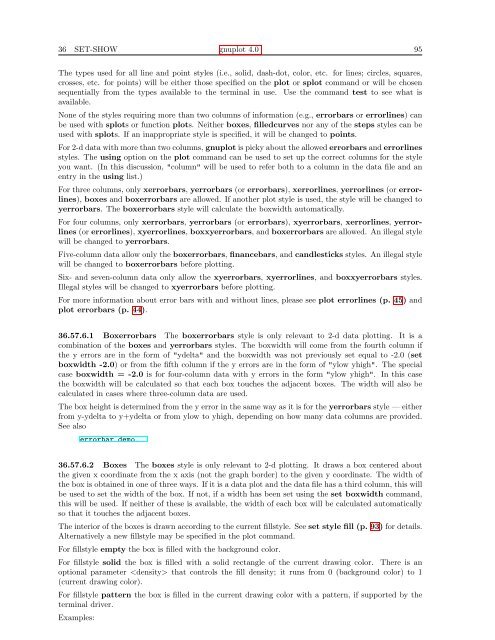GNUPlot Manual
GNUPlot Manual
GNUPlot Manual
You also want an ePaper? Increase the reach of your titles
YUMPU automatically turns print PDFs into web optimized ePapers that Google loves.
36 SET-SHOW gnuplot 4.0 95<br />
The types used for all line and point styles (i.e., solid, dash-dot, color, etc. for lines; circles, squares,<br />
crosses, etc. for points) will be either those specified on the plot or splot command or will be chosen<br />
sequentially from the types available to the terminal in use. Use the command test to see what is<br />
available.<br />
None of the styles requiring more than two columns of information (e.g., errorbars or errorlines) can<br />
be used with splots or function plots. Neither boxes, filledcurves nor any of the steps styles can be<br />
used with splots. If an inappropriate style is specified, it will be changed to points.<br />
For 2-d data with more than two columns, gnuplot is picky about the allowed errorbars and errorlines<br />
styles. The using option on the plot command can be used to set up the correct columns for the style<br />
you want. (In this discussion, "column" will be used to refer both to a column in the data file and an<br />
entry in the using list.)<br />
For three columns, only xerrorbars, yerrorbars (or errorbars), xerrorlines, yerrorlines (or errorlines),<br />
boxes and boxerrorbars are allowed. If another plot style is used, the style will be changed to<br />
yerrorbars. The boxerrorbars style will calculate the boxwidth automatically.<br />
For four columns, only xerrorbars, yerrorbars (or errorbars), xyerrorbars, xerrorlines, yerrorlines<br />
(or errorlines), xyerrorlines, boxxyerrorbars, and boxerrorbars are allowed. An illegal style<br />
will be changed to yerrorbars.<br />
Five-column data allow only the boxerrorbars, financebars, and candlesticks styles. An illegal style<br />
will be changed to boxerrorbars before plotting.<br />
Six- and seven-column data only allow the xyerrorbars, xyerrorlines, and boxxyerrorbars styles.<br />
Illegal styles will be changed to xyerrorbars before plotting.<br />
For more information about error bars with and without lines, please see plot errorlines (p. 45) and<br />
plot errorbars (p. 44).<br />
36.57.6.1 Boxerrorbars The boxerrorbars style is only relevant to 2-d data plotting. It is a<br />
combination of the boxes and yerrorbars styles. The boxwidth will come from the fourth column if<br />
the y errors are in the form of "ydelta" and the boxwidth was not previously set equal to -2.0 (set<br />
boxwidth -2.0) or from the fifth column if the y errors are in the form of "ylow yhigh". The special<br />
case boxwidth = -2.0 is for four-column data with y errors in the form "ylow yhigh". In this case<br />
the boxwidth will be calculated so that each box touches the adjacent boxes. The width will also be<br />
calculated in cases where three-column data are used.<br />
The box height is determined from the y error in the same way as it is for the yerrorbars style — either<br />
from y-ydelta to y+ydelta or from ylow to yhigh, depending on how many data columns are provided.<br />
See also<br />
errorbar demo.<br />
36.57.6.2 Boxes The boxes style is only relevant to 2-d plotting. It draws a box centered about<br />
the given x coordinate from the x axis (not the graph border) to the given y coordinate. The width of<br />
the box is obtained in one of three ways. If it is a data plot and the data file has a third column, this will<br />
be used to set the width of the box. If not, if a width has been set using the set boxwidth command,<br />
this will be used. If neither of these is available, the width of each box will be calculated automatically<br />
so that it touches the adjacent boxes.<br />
The interior of the boxes is drawn according to the current fillstyle. See set style fill (p. 93) for details.<br />
Alternatively a new fillstyle may be specified in the plot command.<br />
For fillstyle empty the box is filled with the background color.<br />
For fillstyle solid the box is filled with a solid rectangle of the current drawing color. There is an<br />
optional parameter that controls the fill density; it runs from 0 (background color) to 1<br />
(current drawing color).<br />
For fillstyle pattern the box is filled in the current drawing color with a pattern, if supported by the<br />
terminal driver.<br />
Examples:

















